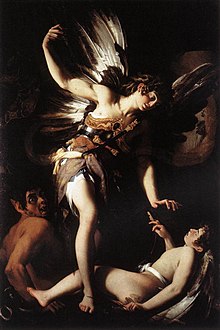
In art, chiaroscuro (English: /kiˌɑːrəˈsk(j)ʊəroʊ/ kee-AR-ə-SKOOR-oh, -SKURE-, Italian: [ˌkjaroˈskuːro]; lit. 'light-dark') is the use of strong contrasts between light and dark, usually bold contrasts affecting a whole composition. It is also a technical term used by artists and art historians for the use of contrasts of light to achieve a sense of volume in modelling three-dimensional objects and figures.[1] Similar effects in cinema, and black and white and low-key photography, are also called chiaroscuro.
Further specialized uses of the term include chiaroscuro woodcut for colour woodcuts printed with different blocks, each using a different coloured ink; and chiaroscuro for drawings on coloured paper in a dark medium with white highlighting.[2]
Chiaroscuro originated in the Renaissance period but is most notably associated with Baroque art.[3] Chiaroscuro is one of the canonical painting modes of the Renaissance (alongside cangiante, sfumato and unione) (see also Renaissance art). Artists known for using the technique include Leonardo da Vinci, Caravaggio,[4] Rembrandt,[5][6] Vermeer,[7] Goya,[8] and Georges de La Tour.
- ^ Glossary of the National Gallery, London [1] (accessed 23 October 2011)
- ^ Iris Brahms (ed.): Gezeichnete Evidentia. Zeichnungen auf kolorierten Papieren in Süd und Nord von 1400 bis 1700, De Gruyter, Berlin/Boston 2022, ISBN 978-3-11-063449-5
- ^ "Chiaroscuro in Art: What Is the Chiaroscuro Technique?".
- ^ "Caravaggio, between shadows and light". www.carredartistes.com. Retrieved January 22, 2019.
- ^ Hall, Marcia B. (1987). Color and Technique in Renaissance Painting: Italy and the North. J.J. Augustin.
- ^ "Chiaroscuro in Painting: The Power of Light and Dark". EmptyEasel.com. July 20, 2007. Retrieved January 22, 2019.
- ^ "Johannes Vermeer". Artble. Retrieved January 22, 2019.
- ^ "Francisco Goya – Spanish Culture". www.enforex.com. Retrieved January 22, 2019.